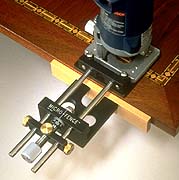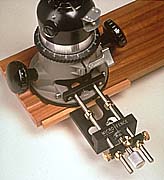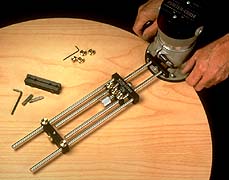
It’s often said that the best tools are the ones that do one job, but do it exceptionally well. That’s what I feel about Micro Fence, an aftermarket router fence system that virtually defines the word “precision.” Elegantly designed and flawlessly machined, this sleek router fence will satisfy even the most finicky woodworker with its wide range of setup options and a silky smooth micrometer adjustment that rewards and astonishes the user with absolutely no backlash.
When Micro Fence emerged onto the woodworking scene, it was unique enough that I still remember my first encounter with it. I was at the 1994 International Woodworking Fair (IWF) show in Atlanta, Georgia, and after turning it over in my hand and playing with it, I turned to its designer and said: “At every show you meet one exhibitor that stands out in your mind. For this show, you are it.”
Micro Fence is the brainchild of sixty-one-year-old furniture maker and tool designer Richard Wedler, known to his friends, myself among them, as Rich. It reflects the marriage of a machinist’s penchant for accuracy with a woodworker’s need for precision. I’ll let Rich explain how it came about.

“I had been working as a custom furniture builder and designer since the early 1970’s,” Rich told me. “My father was a machinist and tool maker, who often worked in my shop doing metal working and making jigs, fixtures, and accessories. In 1993, we started fooling around with the concept of bringing accurate measurement to the router, initially to fill my own needs. The result was the Micro Fence, a micrometer adjusted guide fence for the router. Basically, it is an extremely accurate adjustable edge guide.”
“We went through some early iterations, but the real change came when I went to a woodworking show in Long Beach. I was showing the Micro Fence for the first time to see if there was any interest. Mark Duginske was there as an expert on tooling and machinery. I showed it to Mark, and he encouraged me to to replace my wooden prototype with an aluminum version.”
“We made up an initial run of 500 units and took them to the 1993 Association of Woodworking and Furnishings Suppliers (AWFS) woodworking show in Anaheim [California]. Almost all the major router companies came to check it out, so we concluded that we had a solid concept. We started taking them to woodworking shows, taking out ads in woodworking magazines and signing up dealers. It’s been growing gradually ever since.”
“When we designed the Micro Fence, function was vastly more important than price. As a result, it is not an inexpensive item. Many of the parts are made of stainless steel, both for accuracy and wear characteristics. Other parts are of brass and aluminum with an eye toward preventing corrosion. Each part was designed with elegant simplicity in mind. Simply put, we try to build a tool that we would want to own.”
“While the price may seem a bit high, its quality and value make it a relative bargain. If you saw an equivalent tool in a typical machinist’s catalog, it would probably cost twice as much. What the Micro Fence does is afford you absolute control of the router’s cutter placement and cut size to an accuracy of .001″. It adapts to fit more than 60 different professional makes and models of router, including laminate trimmers.” This, of course, begs the question ‘Why would you need that level of accuracy in wood?’ The reason is, at least in part, due to the inconsistencies in wood.
“Take, for example, a situation in which you need to create an accurate dado for plywood. We all know that three quarter inch plywood is rarely exactly .750″ and until you measure it, there is no way to know. But even after measuring, how many tools allow you to consistently cut an accurate enough dado for a truly flawless fit? Micro Fence does. The same is true of making accurate mortise and tenon joints, lap joints, sliding dovetails, rabbets, inlays and so on. It even allows you to add a few thousandths of clearance for glue, wood movement, or whatever. The bottom line is that this tool gives you absolute dimensional control over your parts, and that’s what makes it a must for any serious woodworker.”

Once the Micro Fence starting gaining loyal users, it spawned siblings. Subsequent variations include a circle jig, which cuts accurate circles from 6″ to over 12 feet in diameter, and a similar wide-ranging elliptical jig for cutting ovals and arcs. Both these jigs mate with vacuum hold-downs that let you positively position them without creating holes or divots in your wood.
My own Micro Fence circle jig turned out to be a lifesaver last year when I was making the sets for a local theater production of “Wizard of Oz.” It let me quickly and accurately cut both the sweeping four-foot roof radiuses, and the tiny round windows, that made up the Emerald City set. Best of all, it got me out of the shop and back to studying my lines in a jiffy, which was important, since I was one of the actors in the production as well.
The newest offering from Micro Fence, scheduled to be released to the general public at the AWFS show in Las Vegas (July 27-30), is a clever plunge base for a trim router, a tool that traditionally does not come with that option. It will boast stainless steel posts, bronze bushings, a finely machined three-position turret, dust collection ports for both above and below the plate, and even an LED light source to illuminate the work area. Its accuracy comes from the Micro Fence micrometer added to control the depth of cut. Of course, it also accepts the Micro Fence edge guide as well. If you are heading to the show this summer, be sure to stop by the booth, take a look at it and, while you are there, tell Rich I said hello.





